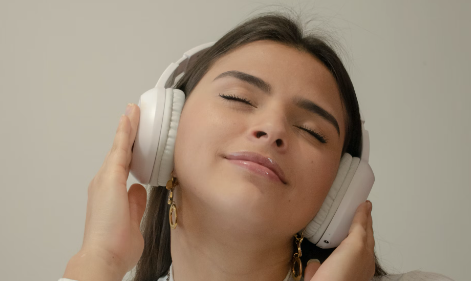Are You Stressed? This Is How You Can Feel Less Pain With Music

Are you scared for your next doctor’s appointment? Well, there is a new reason why you shouldn’t be! While those meet-ups with the doctor (especially with dentists) can be quite painful at times, all you need to do from now on is bring a pair of headphones with you! Yes, you read that right. According to a new study, you can feel less pain with music. So, make sure to bring your good old friend with you the next time you have to go through something painful!
How You Can Feel Less Pain with Music
Recent research suggests that our preferred music not only functions as a potent painkiller but that emotionally moving music might have an even more significant impact. The pain-relieving properties of music have long been recognized, extending to findings indicating relief even in babies. Additionally, studies have shown that individuals’ chosen tunes can outperform the painkilling effects of randomly selected relaxing music.
Researchers from McGill University in Montreal, Canada, have uncovered evidence supporting the idea that the emotional responses generated by music are crucial in its pain-alleviating effects. According to Darius Valevicius, the first author of the research, favorite music has been estimated to reduce pain by about one point on a 10-point scale. This reduction is deemed comparable to the effectiveness of over-the-counter painkillers like Advil (ibuprofen) under similar conditions. Moreover, Valevicius suggests that emotionally moving music may exert an even stronger pain-relieving effect.
What the Study Has to Say
In a study shown in the journal Frontiers in Pain Research, researchers, including Darius Valevicius from McGill University, engaged 63 healthy participants in an experiment. This was done at the Roy pain laboratory on the McGill campus. During the experiment, a probe device was used to heat a specific area on their left arm. This simulated the sensation akin to holding a hot cup of coffee against the skin.
Throughout this process, participants were exposed to different auditory conditions. This included listening to two of their favorite tracks, relaxing music specifically chosen for them, scrambled music, or silence. The participants were then prompted to assess the intensity and unpleasantness of the pain they experienced during each auditory condition. Each participant underwent each condition for roughly seven minutes. During this time the eight pain stimulations and eight corresponding pain intensity and unpleasantness ratings occurred.

Following the auditory stimuli, participants were asked to provide feedback on the music’s pleasantness, their emotional arousal, and the occurrence of “chills”. This is a phenomenon associated with sudden emotions or heightened attention, often manifesting as tingling, shivers, or goosebumps. This multifaceted approach aimed to comprehensively understand the interplay between music, emotional responses, and pain perception.
What Were the Results of the Research Claiming You Can Feel Less pain with music?
The research reveals a significant impact of music on pain perception among participants. When individuals listened to their favorite tracks, they reported a notable reduction in both the intensity and unpleasantness of pain. Specifically, the perceived pain was lowered by around four points on a 100-point scale. On the other hand, the unpleasantness of pain lowered by about nine points. This was different from periods of silence or scrambled sound, where the pain-alleviating effect was not as present. Interestingly, the use of relaxing music, even if chosen for the participants, did not produce a similar pain-reducing effect.

Lead researcher Darius Valevicius emphasized that these results are unlikely to be attributed to placebo effects or expectations. He pointed out a crucial observation. There was a robust correlation between the pleasantness of the music and the unpleasantness of pain. However, there was no corresponding correlation between music pleasantness and pain intensity. This distinction suggests that the pain-alleviating impact of preferred music is not merely a result of psychological expectations. Furthermore, it adds depth to the understanding of how music, emotional responses, and pain perception interact.
What Does the Research Reveal?
Subsequent analysis shows a correlation between music that gave more “chills” and lower levels of both pain intensity and pain unpleasantness. Additionally, lower scores for pain unpleasantness were linked to music rated as more pleasant. Darius Valevicius proposed two potential mechanisms for the observed effects. Chills might have a physiological sensory-gating effect, blocking ascending pain signals. On the other hand, pleasantness could influence the emotional perception of pain without directly affecting the sensation. They operate more at a cognitive-emotional level involving prefrontal brain areas. However, Valevicius emphasized the need for further research to validate these hypotheses.
Interestingly, music rated as more pleasant and inducing more chills tended to be linked with moving or bittersweet tracks. However, the direct impact of such tunes on pain remains unclear.
What Else Research Wants to Consider for Whether You Can Feel Less Pain With Music
The researchers acknowledge that it remains unclear whether moving music would evoke similar chills in individuals who do not prefer it. They also want to know whether those who favor such music are more prone to experiencing musical chills. They show the limitations of the study’s size. Further suggesting that some relationships may not have been detected, and expressing that the duration of playing relaxing music might not have been enough to observe an effect.
Dr. Brendan Rooney from the University College Dublin’s School of Psychology remains skeptical about the notion of a special quality inherent in the music itself. He suggests that participants’ perception of pain while listening to a track could influence their reported feelings. Nevertheless, Rooney notes that this study aligns with his team’s findings. The doctor emphasizes the idea that individuals experiencing pain should have the autonomy to curate their own pain-relief experiences through music and entertainment.
The Iso Principle
This research is not far off from what the Iso Principle suggests. The Iso-principle is a tool that matches a music listening experience with the current mood or emotion and gradually transitions to music showing a desired mood. This method includes avoiding excessive repetition of songs related to negative emotions and progressing toward music that aligns with a more positive mood. Creating a playlist that transitions from uncomfortable to comfortable emotions can serve as a healthy coping strategy, keeping a positive change in mood.

Active music-making has positive effects on neurotransmitters, including dopamine and serotonin, which play key roles in influencing mood. Dopamine impacts focus, concentration, memory, sleep, mood, and motivation, while serotonin influences mood, sleep patterns, anxiety, and pain. Engaging in activities like singing, playing an instrument, or creating music electronically can positively affect these neurotransmitters. Singing in a group, in particular, fosters a sense of connection through the release of oxytocin, a hormone. Furthermore, singing synchronizes breathing patterns, promoting relaxation and reducing cortisol, known as “the stress hormone.”
What About Babies and Children?
When it comes to babies and children, research suggests that playing music, such as a Mozart lullaby, to infants undergoing painful procedures may help lessen their suffering. Despite previous beliefs that babies’ brains are not developed enough to feel pain, recent studies indicate that they experience pain similarly to adults. Dr. Saminathan Anbalagan, a neonatal and perinatal medicine fellow at Thomas Jefferson University Hospital, led a study measuring pain levels in 100 newborns undergoing a heel-prick blood test.
All infants received a small dose of sugar solution before the procedure, but 54 of them also listened to an instrumental Mozart lullaby for 20 minutes before, during, and for five minutes after the test, while the others did not listen to any music. The goal is to create a reliable method for reducing pain in newborns, considering the potential long-term consequences of early pain experiences.
Will you be using music to help relieve your pain from your next doctor’s appointment?
You might also want to read: Boost Your IQ in Under 10 Minutes Through Mozart Effect


